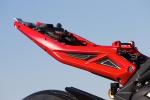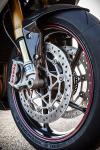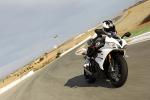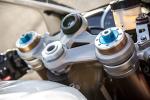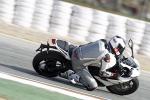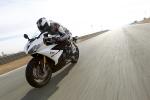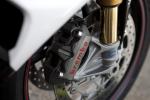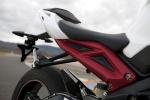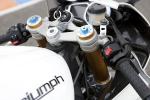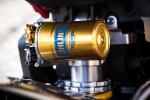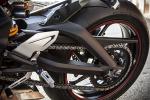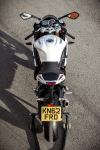Triumph Daytona 675R 2013 review
By Kevin Ash - 18/12/2012
There wasn't a pressing need to do more than facelift the Daytona, but Triumph did do more... A lot more, and in the process might just have built 2013's bike of the year.
The Daytona 675 first appeared in 2006 and immediately became the benchmark bike in the hotly contested supersport class. For 2009 it shed some weight, gained some power and retained its position as class leader, and since the class has imploded in sales terms, development from other manufacturers has slowed or stopped altogether, so a few more tweaks would have kept the 675 at the front.
Instead we've been given an all new bike. The list of carry-over items is remarkably small, amounting to the front mudguard, footrests, brake callipers, switchgear and an assortment of minor components. everything else, including the engine itself, is new.
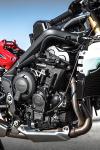
According to Triumph's product manager Simon Warburton, the previous engine couldn't have been developed further without compromising either road manners, durability or both, so a clean sheet was given to the design team with only the outline 675cc, three-cylinder specification to stick to. The result is a motor making an additional 3bhp, which revs 500rpm higher and produces 2Nm more torque. More importantly, the dip in the old engine's torque curve at 7,000rpm has moved right down to just over 4,000rpm, and output has been boosted across almost all the rev range.
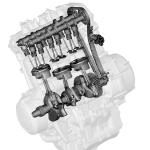
The changes are substantial. The bore and stroke have been revised from 74mm x 52.3mm to 76mm x 49.6mm, more oversquare dimensions designed to let the engine rev higher. This has allowed more room in the roof of the combustion chamber for bigger valves, but Triumph hasn't gone for this default option and instead has been more subtle. The exhaust valves in fact have been reduced in diameter from 25.5mm to 24.2mm, cutting their weight by 7 per cent and in turn allowing increased lift, which has gone up by 0.2mm to 8.7mm. The gas flow has increased anyway as the outer edges of the valves are less shrouded by the cylinder walls than before as there's a bigger gap due to the larger bore.
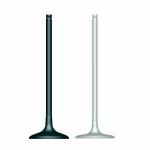
The inlet valve material has been changed to titanium, a first on a production Triumph, and the weight reduction that came with this was so great, it allowed Triumph to add material to the head of the valve (titanium one on left in image left) to improve its shape and aid gas flow. The diameter remains the same at 30.5mm while the stem diameter has increased, but weight is still 4g less at 46.9g, so as with the exhaust valves the lift has been increased, up 0.15mm to 9.4mm.

The valve timing has been adjusted, with slightly reduced duration for the inlets, an increase on the exhaust side and similar overlap. The engine's rev maximum has increased to 14,400rpm, and thanks to the raised compression ratio, average cylinder pressures have increased by 10 per cent. This demanded a significant change in construction as the previous cylinders, integrated with the upper crankcase, weren't quite strong enough to deal with that. So the new all-aluminium cylinder block is cast separately and has Nikasil-coated bores in place of the previous wet steel liners, so the cylinder centres don't have to moved further apart and it can withstand the higher pressures.

There are now two fuel injectors per cylinder, a move usually associated with increased power, as the injector sited in the airbox points straight down the throat of the intake, while the other is positioned conventionally, closer to the inlet valves at an angle to the intake duct. But Triumph found the finer control the set-up allowed also boosted low and mid-range power.
Other changes include improved oil cooling jets aimed at the undersides of the pistons, higher-rated main bearings, larger big end bearings and an integrated aluminium oil cooler at the front of the engine. The lower crankcase now has oil scrapers to lift oil from the crank webs, reducing oil drag, and baffling to prevent surge in severe braking, both ideas coming from Triumph's race experience with the Daytona. The crank assembly has reduced inertia compared with the old one, as does the alternator, for a quicker throttle response and harder acceleration.
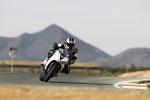
A slip-assist clutch has been fitted, which has angled ramps between the inner and outer housings that pull the clutch plates together under load and push them apart on the overrun to allow them to slip. Because the new bike has a more forward weight distribution than before, the slipper action is aided by engine management electronics which open the secondary throttle butterflies under heavy braking to reduce the engine braking effect.
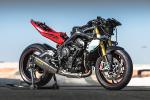
The gearbox has been updated with a range if improvements to the gear selection mechanism, designed to resolve the heavy first-to-second upchanges which could be a problem in track use, while the gears themselves have been revised to improve engagement. The final drive ratio has been reduced through the fitment of a 15 tooth front sprocket in place of the previous 16 tooth one.
The air intake path has been modified, as it was found that the previous design was restricted around the headstock region. This has been enlarged and smoothed out, with an increase of almost 40 per cent in the cross-sectional area.
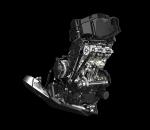
The exhaust is one of the most visible changes as it's moved from the previous underseat location to beneath the engine, moving weight forward and centralising the bike's mass. The programme of mass centralisation has been central to Triumph's changes to the Daytona, allowing the designers to sharpen the steering geometry at the same time as improving stability.
The chassis is completely new too. The frame is the same as the 2013 Street Triple's (click here for review), matched to a lightweight cast aluminium rear subframe, while the swingarm is a new asymmetric design to make room for the silencer, with increased stiffness and reduced weight. It's shorter than the previous one to reduce the overall wheelbase, and the pivot position is adjustable, as before.

At the front of the standard Daytona 675, a pair of KYB 'centre-fixed cartridge' forks are used, which are lighter than conventional items with improved response - these are KYB's (formerly Kayaba) version of the Showa 'Big Piston' forks. At the rear a new KYB shock is used, adjustable for preload, rebound damping and high and low speed compression damping.
On the 675R, as tested here, Öhlins equipment is used. The forks are NIX30 units as on last year's model but recalibrated and with increased travel, up 10mm to 120mm, while at the rear a new TTX36 shock is used. This has a lighter spring as there's less weight at the back of the bike. The R also has Brembo Monobloc callipers at the front, with all-Brembo hydraulic components (the previous version used some Nissin ones). The standard bike has Brembo discs matched to Nissin brakes.
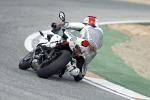
ABS is an option on the 675 and standard on the 675R, and is switchable between road, track and off. In track mode it intervenes later, no longer cutting in when there's a possibility of rear wheel lift, and allowing the rear wheel to spin 40 per cent slower than the front so it's possible to drift the bike into corners. The whole system adds only 1.5kg to the bike.
The changes all mean the wheelbase is 20mm less at 1375mm, weight distribution is now 52.9 per cent on the front (was 51.8 per cent), and the seat height of the standard model is reduced by 10mm, although the 675R is unchanged. The handlebars are repositioned to take a little weight off the wrists, which are now around 5mm higher.

The bodywork is also completely new, including the headlights which are reflector units in place of the old projector ones, which Triumph admits didn't perform well. The reflector ones are claimed to produce a much better throw of light, and as a bonus they weight less too. The rest of the styling is an evolution of the old bike's with a more sophisticated look and leaner rear end, and a host of pleasing details. You can for example quickly remove the number plate hanger and indicator assembly by undoing three bolts and a block connector, while the fairing infill now covers all the wiring and bracketry. On the 675R it's in polished carbon fibre and looks especially good. The R also gets a red subframe, pinstriped wheels and other carbon fibre components. Even the engine mounting bolts are machined.
All of which sounds good, but just wait until you ride it, this bike is phenomenal! It feels better the moment the engine fires up, not only because the signature snarling triple sound is louder than before - just listen to it in the lap of the Cartagena circuit where the press launch took place in the video above - but you get it from lower revs too. There's plenty of leg room even for a taller rider like myself (6'3"/1.92m), and the riding position is a little less radical than before. So, into gear, release the very light clutch and the bike fires forward like no supersport machine has a right to.
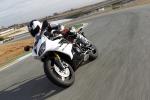
The motor pulls with immense strength even from 5,000rpm, although it really kicks in at 9,000rpm, and it generally feels punchier and more willing than the old model whatever you're asking it to do. As it should: the gearing's lower, the crank inertia is reduced and there's more power pretty much everywhere. What's at least as useful as the new over-rev facility. On the Cartagena circuit where I rode the bike it was possible to hang on to gears in between corners where you'd be bouncing against the rev limiter on the old model, a useful advantage on its own. The revised quickshifter is outstanding too, giving you smooth, near-seamless changes at a touch of the lever, although this was set a little low for me and I found some upchanges difficult as I couldn't get my toe underneath. That should be easy enough to adjust out though.
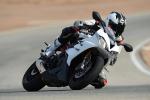
Yet for all the improvements from the engine, it's the chassis which will blow you away. I've never ridden a production bike before with such an improbable combination of agility and stability. Haul the front lever in and the Daytona 675R hunkers down on corner entry with barely a shimmy off your line, even with the rear wheel barely skimming the ground and at Cartagena, a series of bumps and undulations at the end of the start-finish straight pummelling the suspension. Bang down through the gear at the same time, slipper clutch working overtime, and still the bike just sits on line, offering back a new level of tactility as you start to lean it in and release the brake pressure. Front end feel is significantly improved, then you get the bike right over, toe and footrest grazing the ground, and it feels as natural, easy and responsive as anything this side of a race bike. Whatever you're doing the 675R will change direction at a hint of bar pressure, or sit solid and unflappable on the line you've set it, all entirely your choice.
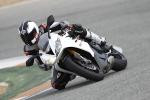
Driving out of corners it's equally astonishing. Some might bemoan the lack of traction control, but it's really not needed on this bike at this power level, the feedback is so astonishingly good. Grip in fact is phenomenal, with no small part played by the new Pirelli Diablo Supercorsa SP tyres fitted as standard. This have a new bi-compound balance with 23 per cent more of the race compound edge, and a 24 per cent larger slick shoulder area, so grip is substantially improved, and it was hardly lacking before. But the bike makes full use, with superb wheel control and once again, sublime stability while firing out of a turn, yet the ability to adjust line instantly and obediently at the nudge of a handlebar to fine tune your trajectory back onto the straight.
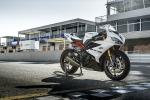
This could well be the perfect bike for learning a new track, but for the majority of track day riders it's going to be their quickest way around a circuit, pretty much any track except maybe the very fastest, while the race versions - and a race kit is also available - are going to clean up the supersport class in 2013. This is a hugely exhilarating and rewarding bike, and what a desperate shame that it sits in a class whose sales have collapsed, as it deserves to be one of the top selling bikes of all sorts. Simon Warburton admitted: "We did think when we started on this that the class would pick up again, and by the time we realised it wasn't going to, we'd reached the point of no return in the development cycle."

In which case, maybe the Daytona 675 will revive the class itself. The R is in exotica territory at more than £10,000, even pricier than the MV Agusta F3 (click here for review), but it'll leave it for dead on the track and it's a far, far more pleasant road bike. You'd have to be seriously badge-biased to forego the British bike for an F3 because you'll be missing out on a clearly superior product, and that's without taking into account Triumph's much better reliability record, dealer network and spares back-up. As for the standard 675, it's going to be outperformed by the 675R, but not by a huge margin as all the basic components are unchanged.
But never mind the category, the Daytona 675R is simply the most satisfying, exhilarating track bike you can buy this side of a BMW HP4 (click here for review), and it's a much more sane proposition on the roads.
Triumph Daytona 675R forum thread
Specifications
Model tested: Triumph Daytona 675R
UK price: £10,599 (Daytona 675, £8,899 + £350)
Available: December 2013
Engine: in line, three cylinder, liquid cooled, dohc 12v, 675cc
Power: 126bhp (128PS, 94kW) @ 12,500rpm
Torque: 55b.ft 74Nm, 7.5kgm) @ 8,000rpm
Economy: n/a
Tank/Range: 3.8 gallon (17.4 litres, 4.6 gallons US) / n/a
Transmission: Six gears, wet, multi-plate slipper clutch, chain final drive
Frame: aluminium dual tube twin spar
Seat height: 32.7in (830mm) (Daytona 675, 32.3in (820mm))
Wheelbase: 54.1in (1375mm)
Rake/trail: 23 °/ 3.46in (87.9mm) (Daytona 675, 22.9 °/ 3.46in (87.2mm))
Weight: 405lb (184kg) wet
Donate to the Kevin Ash Fund
Kevin's funeral was held on Thursday 28th February 2013 and was well attended by family, friends and colleagues.
The Telegraph has very kindly established The Telegraph Kevin Ash Fund to assist with the education of Kevin's three daughters.
If you'd like to make a donation then you can use the PayPal 'Donate' button below which will allow you to donate from your PayPal account, or via credit or debit card. A small percentage (about 3.4%) will be retained by PayPal for the service.
Kevin's family have been touched by the generosity and messages of support from people using the website and would like to express their gratitude to those who have contributed in any way.
The donations keep coming in, thank you so much, and the family especially like it when you leave a message.
Home | ![]() facebook.com/KevinAshFund
|
facebook.com/KevinAshFund
| ![]() twitter.com/KevinAshFund | © 2012
twitter.com/KevinAshFund | © 2012

